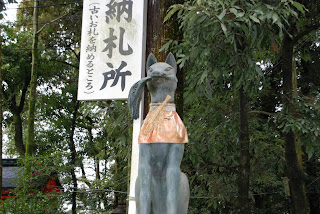Japan has
many temples usually facing the mountain or located up in the mountains. Both the Shinto and Buddhist religions have a
similar style of temple, each using torii gates running from north to south, a
series of corridors running east to west, gardens, spaces for prayer, gardens, etc.
(I like gardens). The construction of all Japanese
temples are the same; consisting of wood posts and beams, tatami straw mat
floors and bark roofs (usually made from cypress). Recent roof replacements use other materials
other than bark.
The temples
are not only a place of worship, but also a place of safekeeping of sacred
objects and a specialization in certain rites.
We visited many temples while in Japan, and one specific temple, Shinto
shrine Fushimi Inari Taisha, is the protectorate of rice and rice
wine. Rice is the most important food of
Asia, especially Japan. I have an
appreciation for the protection of all wines, including sake. So this temple was a must see.
The fox is
considered a messenger of the gods to the Japanese and Fushimi Inari Taisha is
protected by foxes. The fox is prevalent
throughout the temple grounds, including the picture below where the fox is
holding rice in its mouth. Quail eat
rice, therefore killing and eating this bird helps preserve the sacred rice
crop. The small town below the mountain
where the temple is located has many street vendors serving quail. Since I find quail delicious and I want to
help protect the rice wine, I am very much in favor of eating quail.
A trail of more
than 10,000 torii gates leads up the mountain passing various mini-shrines
along the way. People donate money for
the construction of a torii gate to bring good luck. You can stop and pray for the things you need
in life. People will often write their
wishes on a piece of paper and attach it to a tree branch near one of the
shrines. Praying for prosperity and good
health is common, but also finding a suitable person to marry is an important
reason to take the trip up the mountain.
Asians are
very superstitious. The temple lists the
age of people that need special protection (see list of unlucky ages below). If your age is listed, then buying special
protection is a good hedge against bad luck, which I recommend. On one street in the town below the mountain,
falling down the stairs of this street is considered very bad luck and you will
certainly die within 3 years. However,
if you fall on this street, you can buy special protection to prevent your
premature death. I recommend this hedge
as well. The Mafia sells special
protection to protect against physical harm.
If Italians were more superstitious, they would have an easier time selling
protection and nobody would need their arm broken.
We enjoyed
visiting all of the temples and learning what each meant to the people.




















